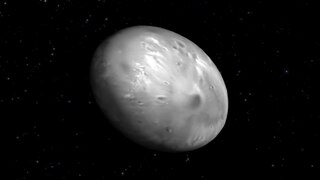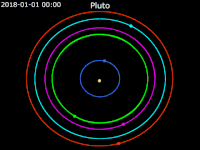
Pluto is a dwarf planet in the Kuiper belt, a ring of bodies beyond the orbit of Neptune. It is the ninth-largest and tenth-most-massive known object to directly orbit the Sun. It is the largest known trans-Neptunian object by volume, by a small margin, but is slightly less massive than Eris. Like other Kuiper belt objects, Pluto is made primarily of ice and rock and is much smaller than the inner planets. Pluto has only one sixth the mass of Earth's moon, and one third its volume.

Charon, known as (134340) Pluto I, is the largest of the five known natural satellites of the dwarf planet Pluto. It has a mean radius of 606 km (377 mi). Charon is the sixth-largest known trans-Neptunian object after Pluto, Eris, Haumea, Makemake and Gonggong. It was discovered in 1978 at the United States Naval Observatory in Washington, D.C., using photographic plates taken at the United States Naval Observatory Flagstaff Station (NOFS).

A natural satellite is, in the most common usage, an astronomical body that orbits a planet, dwarf planet, or small Solar System body. Natural satellites are colloquially referred to as moons, a derivation from the Moon of Earth.

A minor-planet moon is an astronomical object that orbits a minor planet as its natural satellite. As of January 2022, there are 457 minor planets known or suspected to have moons. Discoveries of minor-planet moons are important because the determination of their orbits provides estimates on the mass and density of the primary, allowing insights into their physical properties that are generally not otherwise accessible.

New Horizons is an interplanetary space probe that was launched as a part of NASA's New Frontiers program. Engineered by the Johns Hopkins University Applied Physics Laboratory (APL) and the Southwest Research Institute (SwRI), with a team led by Alan Stern, the spacecraft was launched in 2006 with the primary mission to perform a flyby study of the Pluto system in 2015, and a secondary mission to fly by and study one or more other Kuiper belt objects (KBOs) in the decade to follow, which became a mission to 486958 Arrokoth. It is the fifth space probe to achieve the escape velocity needed to leave the Solar System.

Perdita is an inner satellite of Uranus. Perdita's discovery was complicated. The first photographs of Perdita were taken by the Voyager 2 spacecraft in 1986, but it was not recognized from the photographs for more than a decade. In 1999, the moon was noticed by Erich Karkoschka and reported. But because no further pictures could be taken to confirm its existence, it was officially demoted in 2001. However, in 2003, pictures taken by the Hubble Space Telescope managed to pick up an object where Perdita was supposed to be, finally confirming its existence.

Marc William Buie is an American astronomer and prolific discoverer of minor planets who works at the Southwest Research Institute in Boulder, Colorado in the Space Science Department. Formerly he worked at the Lowell Observatory in Flagstaff, Arizona, and was the Sentinel Space Telescope Mission Scientist for the B612 Foundation, which is dedicated to protecting Earth from asteroid impact events.
The naming of moons has been the responsibility of the International Astronomical Union's committee for Planetary System Nomenclature since 1973. That committee is known today as the Working Group for Planetary System Nomenclature (WGPSN).

Nix is a natural satellite of Pluto, with a diameter of 49.8 km (30.9 mi) across its longest dimension. It was discovered along with Pluto's outermost moon Hydra on 15 May 2005 by astronomers using the Hubble Space Telescope, and was named after Nyx, the Greek goddess of the night. Nix is the third moon of Pluto by distance, orbiting between the moons Styx and Kerberos.

Hydra is a natural satellite of Pluto, with a diameter of approximately 51 km (32 mi) across its longest dimension. It is the second-largest moon of Pluto, being slightly larger than Nix. Hydra was discovered along with Nix by astronomers using the Hubble Space Telescope on 15 May 2005, and was named after the Hydra, the nine-headed underworld serpent in Greek mythology. By distance, Hydra is the fifth and outermost moon of Pluto, orbiting beyond Pluto's fourth moon Kerberos.

The dwarf planet Pluto has five natural satellites. In order of distance from Pluto, they are Charon, Styx, Nix, Kerberos, and Hydra. Charon, the largest, is mutually tidally locked with Pluto, and is massive enough that Pluto–Charon is sometimes considered a double dwarf planet.

A dwarf planet is a small planetary-mass object that is in direct orbit of the Sun, smaller than any of the eight classical planets. The prototypical dwarf planet is Pluto. The interest of dwarf planets to planetary geologists is that they may be geologically active bodies, an expectation that was borne out in 2015 by the Dawn mission to Ceres and the New Horizons mission to Pluto.

15810 Arawn, provisional designation 1994 JR1, is a trans-Neptunian object (TNO) from the inner regions of the Kuiper belt, approximately 133 kilometres (83 mi) in diameter. It belongs to the plutinos, the largest class of resonant TNOs. It was named after Arawn, the ruler of the Celtic underworld, and discovered on 12 May 1994, by astronomers Michael Irwin and Anna Żytkow with the 2.5-metre Isaac Newton Telescope at Roque de los Muchachos Observatory in the Canary Islands, Spain.

Kerberos is a small natural satellite of Pluto, about 19 km (12 mi) in its longest dimension. Kerberos is also the second-smallest moon of Pluto, after Styx. It was the fourth moon of Pluto to be discovered and its existence was announced on 20 July 2011. It was imaged, along with Pluto and its four other moons, by the New Horizons spacecraft in July 2015. The first image of Kerberos from the flyby was released to the public on 22 October 2015.

Mark Robert Showalter is a senior research scientist at the SETI Institute. He is the discoverer of six moons and three planetary rings. He is the Principal Investigator of NASA's Planetary Data System Rings Node, a co-investigator on the Cassini–Huygens mission to Saturn, and works closely with the New Horizons mission to Pluto.

A satellite system is a set of gravitationally bound objects in orbit around a planetary mass object or minor planet, or its barycenter. Generally speaking, it is a set of natural satellites (moons), although such systems may also consist of bodies such as circumplanetary disks, ring systems, moonlets, minor-planet moons and artificial satellites any of which may themselves have satellite systems of their own. Some bodies also possess quasi-satellites that have orbits gravitationally influenced by their primary, but are generally not considered to be part of a satellite system. Satellite systems can have complex interactions including magnetic, tidal, atmospheric and orbital interactions such as orbital resonances and libration. Individually major satellite objects are designated in Roman numerals. Satellite systems are referred to either by the possessive adjectives of their primary, or less commonly by the name of their primary. Where only one satellite is known, or it is a binary with a common centre of gravity, it may be referred to using the hyphenated names of the primary and major satellite.

Chaotic rotation involves the irregular and unpredictable rotation of an astronomical body. Unlike Earth's rotation, a chaotic rotation may not have a fixed axis or period. Because of the conservation of angular momentum, chaotic rotation is not seen in objects that are spherically symmetric or well isolated from gravitational interaction, but is the result of the interactions within a system of orbiting bodies, similar to those associated with orbital resonance.

Organa is the informal name given to a crater on Pluto's largest moon, Charon. The crater was discovered by NASA's New Horizons space probe on its flyby of Pluto. The name was chosen as a reference to Leia Organa from the Star Wars media franchise, which keeps with the theme of naming Charon's craters after science fiction characters. Organa crater is rich in frozen ammonia, which suggests it was created very recently. This crater is located in the northern Pluto-facing hemisphere of Charon.

Harold Anthony "Hal" Weaver, Jr. is an American astronomer, known for his research into the composition of solar system bodies including comets and Kuiper belt objects.

























